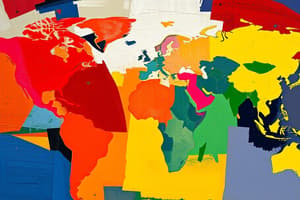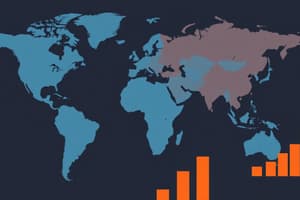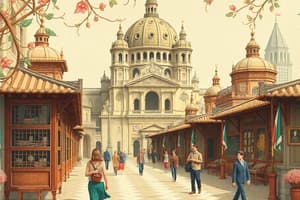Podcast
Questions and Answers
Which type of government is characterized by a state holding broad powers to serve the public interest and deciding what goods and services are produced and in what quantities?
Which type of government is characterized by a state holding broad powers to serve the public interest and deciding what goods and services are produced and in what quantities?
- Monarchy
- Dictatorship
- One-party system
- Centrally planned socialism (correct)
In which economic system do individuals and firms allocate resources, production resources are privately owned, and the government's role is to promote competition among firms and ensure consumer protection?
In which economic system do individuals and firms allocate resources, production resources are privately owned, and the government's role is to promote competition among firms and ensure consumer protection?
- Nordic model
- Centrally planned socialism
- Market capitalism (correct)
- Centralized capitalism
Which type of economy involves a mix of state ownership and private ownership, high taxes, some market regulation, and a generous social safety net?
Which type of economy involves a mix of state ownership and private ownership, high taxes, some market regulation, and a generous social safety net?
- Social market economy model (correct)
- Centralized capitalism
- Centrally planned socialism
- Anglo-saxon model
Which country is associated with the Nordic model of economic system?
Which country is associated with the Nordic model of economic system?
In which type of economy does the government own entire industries and control distribution, with little reliance on product differentiation, advertising, and pricing strategy?
In which type of economy does the government own entire industries and control distribution, with little reliance on product differentiation, advertising, and pricing strategy?
Which economic system is characterized by an environment of private resource ownership and extensive command resource allocation?
Which economic system is characterized by an environment of private resource ownership and extensive command resource allocation?
Which type of economy is associated with private ownership, a free enterprise economy, minimal social safety net, and highly flexible employment policies?
Which type of economy is associated with private ownership, a free enterprise economy, minimal social safety net, and highly flexible employment policies?
Which variable is considered in rankings of economic freedom among countries?
Which variable is considered in rankings of economic freedom among countries?
Which of the following countries is categorized as 'Free' in terms of economic freedom?
Which of the following countries is categorized as 'Free' in terms of economic freedom?
What type of government involves a single political party having control over the government and society?
What type of government involves a single political party having control over the government and society?
What is the purpose of the global marketing plan discussed in the text?
What is the purpose of the global marketing plan discussed in the text?
According to the text, what are the three main factors for market selection in the 5-stage decision model?
According to the text, what are the three main factors for market selection in the 5-stage decision model?
What percentage of economic integration was present in the early 20th century according to the text?
What percentage of economic integration was present in the early 20th century according to the text?
Which two entities are mentioned as being very integrated in the text?
Which two entities are mentioned as being very integrated in the text?
What has replaced trade as the driving force of the world economy according to the text?
What has replaced trade as the driving force of the world economy according to the text?
What has become uncoupled from employment according to the text?
What has become uncoupled from employment according to the text?
What has gone down in terms of value according to the text?
What has gone down in terms of value according to the text?
What has also gone down but more than the value of goods according to the text?
What has also gone down but more than the value of goods according to the text?
What is the 5-stage decision model used for in global marketing plan development according to the text?
What is the 5-stage decision model used for in global marketing plan development according to the text?
What is the GNI per capita range for low-middle-income countries?
What is the GNI per capita range for low-middle-income countries?
Which group of countries has the highest sustained rates of economic growth among the listed countries?
Which group of countries has the highest sustained rates of economic growth among the listed countries?
What is the focus of the Big Emerging Markets (BEMs) identified 15 years ago?
What is the focus of the Big Emerging Markets (BEMs) identified 15 years ago?
Which countries are included in the BRICS?
Which countries are included in the BRICS?
What type of countries have a GNI per capita of $12,476 or more?
What type of countries have a GNI per capita of $12,476 or more?
What records all economic transactions between residents and the rest of the world?
What records all economic transactions between residents and the rest of the world?
What market enables businesses to do business globally with different currencies?
What market enables businesses to do business globally with different currencies?
'Entering developing markets is fruitless because goods are too cheap to make a profit' represents a mistaken assumption about:
'Entering developing markets is fruitless because goods are too cheap to make a profit' represents a mistaken assumption about:
'Poor people in developing countries have money' represents a mistaken assumption about:
'Poor people in developing countries have money' represents a mistaken assumption about:
'They will not waste money on non-essential goods' represents a mistaken assumption about:
'They will not waste money on non-essential goods' represents a mistaken assumption about:
Flashcards are hidden until you start studying
Study Notes
- The text discusses various stages of market development based on Gross National Income (GNI) and identifies countries in each category.
- Big emerging markets (BEMs) were identified 15 years ago, with a focus on Central Europe, Latin America, and Asia.
- Currently, the focus is on BRICS (Brazil, Russia, India, China, and South Africa) as BEMs.
- Low-income countries have a GNI per capita of $1045 or less, with limited industrialization and high agriculture dependency.
- Low-middle-income countries have a GNI per capita between $1046 and $4125, with expanding consumer markets and increasing urbanization.
- The 50 bottom-ranked countries are called Least Developed Countries (LDCs), and India is the only BRIC nation among them.
- Upper-middle-income countries have a GNI per capita between $4126 and $12,745, with rapidly industrializing economies and increasing literacy rates.
- Newly industrializing economies like Egypt, Indonesia, the Philippines, Mexico, and Turkey have the highest sustained rates of economic growth.
- MISTAKEN ASSUMPTIONS ABOUT LDCs:
- Poor people in developing countries have money.
- They will not waste money on non-essential goods.
- Entering developing markets is fruitless because goods are too cheap to make a profit.
- Global companies doing business in developing countries will be seen as exploiting the poor.
- High-income countries have a GNI per capita of $12,476 or more.
- G-7 is a group of seven countries aiming for global economic stability and prosperity, including the USA, Japan, Germany, France, Britain, and Canada.
- G-20 was established in 1999 with 19 countries and the EU, including Russia.
- OECD is a post-WW2 organization promoting economic growth and social well-being with 34 nations.
- Companies need to be equally strong in each part of the world to succeed.
- Product saturation levels indicate the percentage of potential buyers who own a product.
- Balance of payments records all economic transactions between residents and the rest of the world.
- Current account records recurring trade in merchandise, services, and humanitarian aid.
- Capital account records long-term direct investment, portfolio investment, and capital flows.
- Foreign exchange enables businesses to do business globally with different currencies.
- Exchange risk occurs when the value of a currency changes as it is traded.
- Spot market: immediate delivery, forward market: future delivery.
- Countries can devalue, revalue, or maintain the value of their currency.
- Currency markets include countries, central banks, companies converting foreign currency, and currency speculators.
- Managing economic exposure refers to the impact of currency fluctuations on a company's financial performance.
Studying That Suits You
Use AI to generate personalized quizzes and flashcards to suit your learning preferences.




